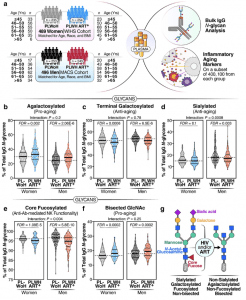People living with HIV (PLWH) often face a higher risk of age-related diseases despite controlling the virus with antiretroviral therapy (ART). Researchers have uncovered a surprising culprit: sugar abnormalities in the blood (Figure 1).

Figure 1: Long-term ART-suppressed HIV infection is associated with sex-dependent IgG N-glycan alterations. a Overview of the main study design. b−f Violin plots displaying the levels of IgG N-glycan groups in WLWH and MLWH undergoing long-term ART compared to their PLWoH controls. The median and interquartile range (IQR) are shown. Two-tailed unpaired t tests and false discovery rates (FDRs) were calculated to account for multiple tests over studied markers. Interaction P values were calculated using multivariable models, adjusting for age, ethnicity, and BMI. N = 985 biological samples. g A schematic summary illustrating the IgG N-glycan alterations associated with HIV infection and/or ART treatment. Source data are provided as a Source Data file.
This study, involving over 1200 participants, identified distinct sugar patterns in the blood of PLWH. These abnormal sugar structures are part of a complex network of sugars called the “glycome.” Previous research linked changes in the glycome to natural aging, with a shift from anti-inflammatory to pro-inflammatory sugar signatures.
The study investigated whether chronic HIV infection might accelerate these glycomic changes. The findings revealed elevated levels of inflammatory and pro-aging sugar signatures in the immune system proteins (IgGs) of PLWH. This suggests a potential link between HIV and the increased risk of age-related diseases observed in this population.
Building on this discovery, researchers developed a machine-learning model that utilizes these sugar signatures to estimate biological age and aging acceleration in PLWH. This model could potentially predict the earlier onset of age-related illnesses like cancer, allowing for proactive healthcare measures.
To solidify the connection between sugar abnormalities and diminished immune function, the researchers created lab-made HIV antibodies with altered sugar structures similar to those seen in PLWH. These modified antibodies proved less effective in fighting infected cells compared to normal antibodies. Conversely, antibodies engineered with sugar patterns resembling those of younger individuals displayed enhanced immune response.
This research opens doors for a paradigm shift in HIV care. By analyzing sugar signatures, healthcare professionals might be able to predict and potentially prevent the development of age-related complications in PLWH. This paves the way for a more personalized and proactive approach to managing HIV infection.
Journal article: Giron, L.B., et al. 2024. Immunoglobulin G N-glycan markers of accelerated biological aging during chronic HIV infection. Nature Communications.
Summary by Stefan Botha










